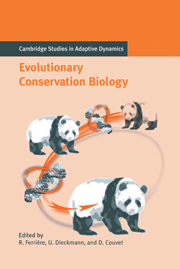Book contents
- Frontmatter
- Contents
- Contributing Authors
- Acknowledgments
- Notational Standards
- 1 Introduction
- Part A Theory of Extinction
- Part B The Pace of Adaptive Responses to Environmental Change
- Part C Genetic and Ecological Bases of Adaptive Responses
- Part D Spatial Structure
- Part E Community Structure
- References
- Index
- The International Institute for Applied Systems Analysis
Part D - Spatial Structure
Published online by Cambridge University Press: 15 August 2009
- Frontmatter
- Contents
- Contributing Authors
- Acknowledgments
- Notational Standards
- 1 Introduction
- Part A Theory of Extinction
- Part B The Pace of Adaptive Responses to Environmental Change
- Part C Genetic and Ecological Bases of Adaptive Responses
- Part D Spatial Structure
- Part E Community Structure
- References
- Index
- The International Institute for Applied Systems Analysis
Summary
Introduction to Part D
Human population growth and economic activity convert vast natural areas to serve for settlement, agriculture, and forestry, which leads to habitat destruction, habitat degradation, and habitat fragmentation. These forces are among the most potent causes of species decline and biodiversity loss. Habitat destruction contributes to the extinction risk of three-quarters of the threatened mammals of Australasia and the Americas, and of more than half of the world's endangered birds. Populations confronted with the degradation of their local environment (in excess of the tolerance conferred by phenotypic plasticity) can exhibit two basic types of evolutionary response: either they stay put and adapt to the new local environmental conditions, or they adapt in ways that allow individuals to shift their spatial range efficiently in search of better habitats. In Parts B and C, attention is focused on the former type of adaptation. It is evident that to account for spatial heterogeneity in populations and habitats raises formidable empirical and theoretical challenges. Part D reviews the current achievements and challenges in understanding the role of spatial processes in the persistence of natural populations.
Increased fragmentation typically reduces the size of local populations and/or the flow of migrants between them. This enhances extinction risks, because of either a higher sensitivity of the isolated local populations to demographic stochasticity, or a diminished probability of rescue through immigration. Also, increased fragmentation may affect evolutionary processes in many ways, through a variety of conflicting genetic and demographic effects.
- Type
- Chapter
- Information
- Evolutionary Conservation Biology , pp. 225 - 228Publisher: Cambridge University PressPrint publication year: 2004



